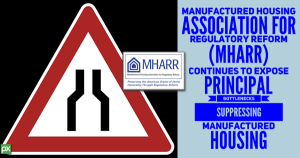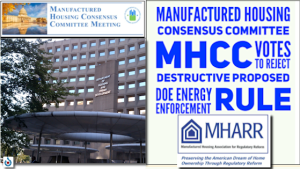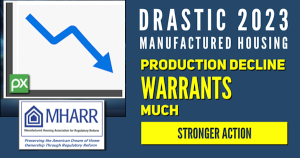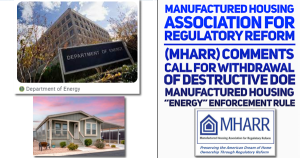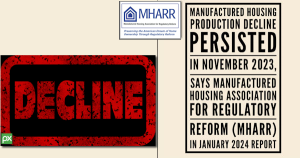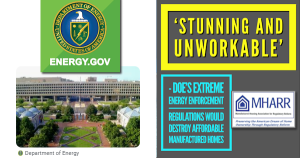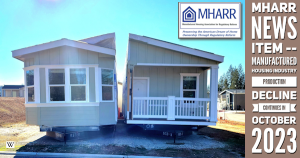Lies, Damned Lies and DOE’s Energy Rule
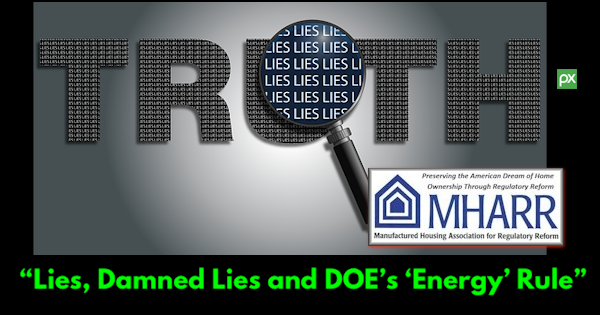
MHARR – ISSUES AND PERSPECTIVES
BY MARK WEISS
MARCH 2022
“Lies, Damned Lies and DOE’s ‘Energy’ Rule”
Well, the various comment periods for the U.S. Department of Energy’s (DOE) egregious manufactured housing “energy conservation standards” rule have now ended. In their wake, the record is littered with the predictably disingenuous droppings of its obsequious cheerleaders. Their comments, supporting high-cost DOE manufactured housing “energy” standards generally and, more particularly, the ultra-costly, “single-tier” variant of the proposed standards, were obviously cribbed, in most cases, from the same canned template. Praising, in lockstep, supposed “life-cycle” savings that would magically flow from DOE’s draconian standards, these comments almost-universally, either misrepresent or ignore key facts that if addressed candidly, would totally undermine their dogma-driven claims.
One initial point worth noting about these comments is their common grounding in ignorance. Ignorance of the relevant facts. Ignorance of relevant federal law concerning manufactured housing (i.e., the Manufactured Housing Improvement Act of 2000 as well as the Energy Independence and Security Act of 2007). Ignorance of manufactured housing as legitimate, affordable housing, ignorance of manufactured housing from an engineering, regulatory and feasibility perspective, ignorance of manufactured housing’s unique evolution from “trailers” and “mobile homes” to modern, legitimate, affordable housing, ignorance of the manufactured housing market, ignorance of the manufactured housing consumer financing market, ignorance of the role of manufactured housing in providing affordable, non-subsidized homeownership, and ignorance (either feigned or actual) of the fundamentally-corrupted, sham “process” that has infected the DOE manufactured housing energy standards rulemaking from the start. Like all true ideologues, however, DOE’s booster club does not let ignorance get in the way of their favored narrative. Quite the contrary, ignorance characterizes – and is used to “weaponize” — their narrative from the start.
If these ideologues had any meaningful grounding in the relevant facts and law, they would know that the Manufactured Housing Improvement Act of 2000 (2000 reform law) fundamentally changed both substance and procedure relating to the construction and installation of manufactured homes. On substance, the 2000 reform law marked the transition of the industry’s homes from the “trailers” and “mobile homes” of yesteryear to today’s modern, legitimate, inherently affordable manufactured homes – homes with energy costs that are already below those of site-built homes, as detailed below. On procedure, the 2000 reform law established a “balanced’ consensus process for the development of all manufactured housing construction, safety and installation standards.
Based on these laws (i.e., the 2000 reform law and EISA), DOE — as MHARR has continually asserted — should have conducted this entire rulemaking, from the start, within the standards development process mandated by Section 604 of the 2000 reform law, including the central involvement of the Manufactured Housing Consensus Committee (MHCC), using its credible process and indisputable knowledge of today’s manufactured housing, to produce whatever legitimate, cost–effective manufactured housing energy standards – if any – that might have been both warranted and appropriate. Instead, the entire DOE “process,” including its phony, afterthought “consultation” with the MHCC, has been a sham.
Perhaps the most glaring example of the DOE supporters’ underlying ignorance can be found in the comments filed by a group of eleven “woke” state attorneys general (AGs), as well as the Corporation Counsel of that well-known affordable housing hotspot, New York City. These comments, together with those of the various energy special interests and even some within the industry at an earlier phase of DOE’s rulemaking, show how this rulemaking went so wrong and so far off track. Moreover, they demonstrate why such states in particular face an affordable housing crisis, why housing is disproportionately costly in many of those same states, and why so many of those states are losing population. That said, three fundamental and intrinsically-related fallacies, with respect to modern, legitimate, post-2000 reform law manufactured homes, stand out in these (and virtually all other) DOE-supportive comments.
First, they proceed from a false premise. Specifically, the state comments (and many others) imply that manufactured homeowners and residents somehow pay disproportionately higher out-of-pocket energy costs than other homeowners. The state comments, for example, assert that “the average energy cost per square foot” for a manufactured home “is 70% higher” than “an average single-family, site-built home.” Without saying anything more to qualify or contextualize this statement, readers are left with the false impression that manufactured homeowners pay more in energy costs than those in site-built homes. And yet, that is untrue.
As official U.S. Census Bureau data demonstrates, the average monthly energy costs actually paid by manufactured homeowners and residents are, in fact, less (and in some cases significantly less) than the average monthly energy costs actually paid by single-family site-built homeowners and residents across all common fuel types. Thus, average monthly electricity costs in a HUD-Code home are 5.6% less than a site-built home, average monthly natural gas costs in a HUD Code home are 17.8% less than a site-built home, and average monthly fuel oil costs in a HUD Code home are 38.4% less than a site-built home. These cost differentials, moreover, exceed the manufactured home energy cost savings shown by the preceding iteration of the Census Bureau’s American Housing Survey, thus illustrating the continuing progression of manufactured housing toward greater energy efficiency without high-cost DOE standards.
Second, therefore – and directly contrary to the premise of the AGs and nearly all DOE energy rule supporters — for a given home, on a home-to-home basis, manufactured housing monthly energy costs, i.e., the energy costs actually incurred by manufactured homeowners and residents are, in fact, lower than the energy costs actually incurred by site-built homeowners and residents. From the perspective of an actual homeowner, or resident – i.e., the constituency that DOE, the woke AGs and other assorted pro-regulation activists supposedly seek to “protect” — it is entirely irrelevant whether the lower energy operating cost of a manufactured home is attributable to the smaller footprint of the average manufactured home. The fact that matters, is that for that homeowner or resident, in a modern manufactured home, energy costs today are less, without any DOE standards, than energy costs for a site-built home. Energy costs per square foot, conversely, are irrelevant and affirmatively misleading. Quite simply, real manufactured homeowners and residents do not live in fictional, make-believe, or “theoretical” homes that are identical in size (and conditioned space) to site-built homes. In the real world, where real people live, work and pay bills, energy costs for an average, modern manufactured home are significantly less than the energy bills for an average site-built home.
Virtually all the DOE supporters, however, ignore this key point, choosing instead to misrepresent, through the omission of critical information, the actual energy costs paid by current-day manufactured homeowners and residents.
“Well,” those DOE supporters would undoubtedly argue, even if the energy costs paid by manufactured homeowners and residents are already lower than those of site-built homeowners and residents, DOE’s proposed standards would still be a net positive, because those standards – allegedly – would reduce the energy costs of manufactured homes for owners and residents even further over the life of the home – i.e., a lower “life-cycle” cost (although this is, in itself, fiercely disputed). Even assuming, though, for the sake of argument that this premise were true (which it is not) it would still be totally undermined by the third major fallacy inherent in the pro-DOE comments.
That Third Fallacy is the DOE-supporters’ near-universal failure to acknowledge and address the mass exclusion from the manufactured housing market that would result from the imposition of ultra-high-cost DOE energy standards. Put differently, they fail to acknowledge or even recognize that significantly-higher purchase prices for manufactured homes would exclude large numbers of lower-income buyers from the manufactured housing market. They similarly fail to acknowledge that for that large excluded population, there would be absolutely no “life-cycle” savings and no “benefit” whatsoever from the proposed standards. To the contrary, for those excluded from homeownership by regulatory-driven purchase price increases, the DOE standards would have absolutely no benefits, only costs, i.e., the cost of market exclusion.
DOE’s supporters, accordingly, assert (or imply) a false premise – i.e., that manufactured homeowners and residents are paying disproportionately more for energy than other homeowners. To supposedly “remedy” this false premise – a “problem” invented out of whole-cloth — the same special interests maintain that ultra-high-cost DOE manufactured housing energy standards are necessary. Yet virtually none of those supporters address the impact that the mandatory imposition of those standards would have on the purchase price of the typical manufactured home, and the impact that such price increases would have on the manufactured housing market and American families who rely on manufactured housing for affordable homeownership. And the reason for the effort to deep-six this fundamental issue is not surprising. Quite simply, the ultra-high-cost DOE standards would decimate the mainstream manufactured housing market and undermine the availability of affordable housing that is already millions of units below what is needed nationally, according to multiple analyses.
MHARR addressed this issue in its initial October 25, 2021 DOE comments. Based on National Association of Home Builders (NAHB) market analytics, MHARR concluded that purchase price increases resulting from the DOE proposed rule would exclude almost seven million households from the manufactured housing market. This loss, per se, would occur primarily among the lowest income households that currently qualify for purchase financing, and would sharply exacerbate the already inequitably-high rejection rate among minority applicants for manufactured home personal property loans documented in a May 2021 Consumer Financial Protection Bureau (CFPB) report, directly contrary to the “equity” policies of President Biden.
Rather than conduct their own research into this key issue, the “woke” AGs instead cite “analyses performed by Next Step,” a group that has received funding and support from the Manufactured Housing Institute, Clayton Homes, Inc. and Fannie Mae, among others. According to the AGs, those purported analyses “confirm that despite potential increases in purchase price due to …improved [energy] efficiency requirements, a manufactured home built to DOE’s proposed IECC-based standards would remain affordable to even the most price-sensitive consumers….” (Emphasis added). This would involve, however, a fundamental change to the very nature of manufactured housing that, once unleashed, could never be “undone.”
Right now and for the past half century, manufactured homes, as an intended by federal law, are (and have been) organically affordable for all Americans — meaning that the home itself is inherently affordable, without the need for subsidies or any other type of outside, third-party involvement to ensure a low up-front acquisition cost to the homebuyer. In this way, manufactured housing is fundamentally and intrinsically different from all other types of single-family housing. Under Next Step’s formulation, however, as endorsed by the “woke” AGs, that inherent free-market-based affordability would be replaced by – you guessed it – never-ending dependence on promised government subsidies and related largesse.
According to Next Step, souped-up, “energy efficient” manufactured homes, with souped-up price tags to match, would “remain affordable to even the most price-sensitive” buyers “due to the availability of federal and state tax incentives, and loan and down-payment assistance programs to assist low income home buyers.” So, with no specifics on anything – i.e., the nature of such programs, their requirements, their availability, their potential disadvantages or negatives, potential restrictions or conditions on their use, and dozens of other questions, variables and possible pitfalls (including, but not limited to entrenched state and local discrimination against HUD Code homes), manufactured housing consumers and the HUD Code industry are supposed to sacrifice the inherent, fundamental, non-conditional and non-subsidized market-based affordability of manufactured housing – guaranteed by federal statute for nearly a half-century – in exchange for government “promises” that could be withdrawn, altered, or eliminated at any time and may not be available in any event once all the facts are known (as MHARR will elaborate in a soon-to-be-released White Paper)? No thanks.
As MHARR has consistently maintained, DOE manufactured housing energy standards are a non-solution for a problem that does not exist in reality. Today’s modern, affordable manufactured homes are already energy-efficient in terms of the costs actually paid by owners and residents. The DOE proposed standards, consequently, are a non-remedy, for a non-problem, that will hurt the least-advantaged the most. As a result, DOE’s energy rule needs to go back to the drawing board for a legitimate development process that fully complies with both the 2000 reform law and EISA by following HUD’s unique statutory rulemaking process, including statutorily-mandated MHCC involvement from the start – not as an afterthought.
Mark Weiss
MHARR is a Washington, D.C.-based national trade association representing the views and interests of independent producers of federally-regulated manufactured housing.
“MHARR-Issues and Perspectives” is available for re-publication in full (i.e., without alteration or substantive modification) without further permission and with proper attribution to MHARR.
MHARR – ISSUES AND PERSPECTIVES
BY MARK WEISS
MARCH 2022
“Lies, Damned Lies and DOE’s ‘Energy’ Rule”
Well, the various comment periods for the U.S. Department of Energy’s (DOE) egregious manufactured housing “energy conservation standards” rule have now ended. In their wake, the record is littered with the predictably disingenuous droppings of its obsequious cheerleaders. Their comments, supporting high-cost DOE manufactured housing “energy” standards generally and, more particularly, the ultra-costly, “single-tier” variant of the proposed standards, were obviously cribbed, in most cases, from the same canned template. Praising, in lockstep, supposed “life-cycle” savings that would magically flow from DOE’s draconian standards, these comments almost-universally, either misrepresent or ignore key facts that if addressed candidly, would totally undermine their dogma-driven claims.
One initial point worth noting about these comments is their common grounding in ignorance. Ignorance of the relevant facts. Ignorance of relevant federal law concerning manufactured housing (i.e., the Manufactured Housing Improvement Act of 2000 as well as the Energy Independence and Security Act of 2007). Ignorance of manufactured housing as legitimate, affordable housing, ignorance of manufactured housing from an engineering, regulatory and feasibility perspective, ignorance of manufactured housing’s unique evolution from “trailers” and “mobile homes” to modern, legitimate, affordable housing, ignorance of the manufactured housing market, ignorance of the manufactured housing consumer financing market, ignorance of the role of manufactured housing in providing affordable, non-subsidized homeownership, and ignorance (either feigned or actual) of the fundamentally-corrupted, sham “process” that has infected the DOE manufactured housing energy standards rulemaking from the start. Like all true ideologues, however, DOE’s booster club does not let ignorance get in the way of their favored narrative. Quite the contrary, ignorance characterizes – and is used to “weaponize” — their narrative from the start.
If these ideologues had any meaningful grounding in the relevant facts and law, they would know that the Manufactured Housing Improvement Act of 2000 (2000 reform law) fundamentally changed both substance and procedure relating to the construction and installation of manufactured homes. On substance, the 2000 reform law marked the transition of the industry’s homes from the “trailers” and “mobile homes” of yesteryear to today’s modern, legitimate, inherently affordable manufactured homes – homes with energy costs that are already below those of site-built homes, as detailed below. On procedure, the 2000 reform law established a “balanced’ consensus process for the development of all manufactured housing construction, safety and installation standards.
Based on these laws (i.e., the 2000 reform law and EISA), DOE — as MHARR has continually asserted — should have conducted this entire rulemaking, from the start, within the standards development process mandated by Section 604 of the 2000 reform law, including the central involvement of the Manufactured Housing Consensus Committee (MHCC), using its credible process and indisputable knowledge of today’s manufactured housing, to produce whatever legitimate, cost–effective manufactured housing energy standards – if any – that might have been both warranted and appropriate. Instead, the entire DOE “process,” including its phony, afterthought “consultation” with the MHCC, has been a sham.
Perhaps the most glaring example of the DOE supporters’ underlying ignorance can be found in the comments filed by a group of eleven “woke” state attorneys general (AGs), as well as the Corporation Counsel of that well-known affordable housing hotspot, New York City. These comments, together with those of the various energy special interests and even some within the industry at an earlier phase of DOE’s rulemaking, show how this rulemaking went so wrong and so far off track. Moreover, they demonstrate why such states in particular face an affordable housing crisis, why housing is disproportionately costly in many of those same states, and why so many of those states are losing population. That said, three fundamental and intrinsically-related fallacies, with respect to modern, legitimate, post-2000 reform law manufactured homes, stand out in these (and virtually all other) DOE-supportive comments.
First, they proceed from a false premise. Specifically, the state comments (and many others) imply that manufactured homeowners and residents somehow pay disproportionately higher out-of-pocket energy costs than other homeowners. The state comments, for example, assert that “the average energy cost per square foot” for a manufactured home “is 70% higher” than “an average single-family, site-built home.” Without saying anything more to qualify or contextualize this statement, readers are left with the false impression that manufactured homeowners pay more in energy costs than those in site-built homes. And yet, that is untrue.
As official U.S. Census Bureau data demonstrates, the average monthly energy costs actually paid by manufactured homeowners and residents are, in fact, less (and in some cases significantly less) than the average monthly energy costs actually paid by single-family site-built homeowners and residents across all common fuel types. Thus, average monthly electricity costs in a HUD-Code home are 5.6% less than a site-built home, average monthly natural gas costs in a HUD Code home are 17.8% less than a site-built home, and average monthly fuel oil costs in a HUD Code home are 38.4% less than a site-built home. These cost differentials, moreover, exceed the manufactured home energy cost savings shown by the preceding iteration of the Census Bureau’s American Housing Survey, thus illustrating the continuing progression of manufactured housing toward greater energy efficiency without high-cost DOE standards.
Second, therefore – and directly contrary to the premise of the AGs and nearly all DOE energy rule supporters — for a given home, on a home-to-home basis, manufactured housing monthly energy costs, i.e., the energy costs actually incurred by manufactured homeowners and residents are, in fact, lower than the energy costs actually incurred by site-built homeowners and residents. From the perspective of an actual homeowner, or resident – i.e., the constituency that DOE, the woke AGs and other assorted pro-regulation activists supposedly seek to “protect” — it is entirely irrelevant whether the lower energy operating cost of a manufactured home is attributable to the smaller footprint of the average manufactured home. The fact that matters, is that for that homeowner or resident, in a modern manufactured home, energy costs today are less, without any DOE standards, than energy costs for a site-built home. Energy costs per square foot, conversely, are irrelevant and affirmatively misleading. Quite simply, real manufactured homeowners and residents do not live in fictional, make-believe, or “theoretical” homes that are identical in size (and conditioned space) to site-built homes. In the real world, where real people live, work and pay bills, energy costs for an average, modern manufactured home are significantly less than the energy bills for an average site-built home.
Virtually all the DOE supporters, however, ignore this key point, choosing instead to misrepresent, through the omission of critical information, the actual energy costs paid by current-day manufactured homeowners and residents.
“Well,” those DOE supporters would undoubtedly argue, even if the energy costs paid by manufactured homeowners and residents are already lower than those of site-built homeowners and residents, DOE’s proposed standards would still be a net positive, because those standards – allegedly – would reduce the energy costs of manufactured homes for owners and residents even further over the life of the home – i.e., a lower “life-cycle” cost (although this is, in itself, fiercely disputed). Even assuming, though, for the sake of argument that this premise were true (which it is not) it would still be totally undermined by the third major fallacy inherent in the pro-DOE comments.
That Third Fallacy is the DOE-supporters’ near-universal failure to acknowledge and address the mass exclusion from the manufactured housing market that would result from the imposition of ultra-high-cost DOE energy standards. Put differently, they fail to acknowledge or even recognize that significantly-higher purchase prices for manufactured homes would exclude large numbers of lower-income buyers from the manufactured housing market. They similarly fail to acknowledge that for that large excluded population, there would be absolutely no “life-cycle” savings and no “benefit” whatsoever from the proposed standards. To the contrary, for those excluded from homeownership by regulatory-driven purchase price increases, the DOE standards would have absolutely no benefits, only costs, i.e., the cost of market exclusion.
DOE’s supporters, accordingly, assert (or imply) a false premise – i.e., that manufactured homeowners and residents are paying disproportionately more for energy than other homeowners. To supposedly “remedy” this false premise – a “problem” invented out of whole-cloth — the same special interests maintain that ultra-high-cost DOE manufactured housing energy standards are necessary. Yet virtually none of those supporters address the impact that the mandatory imposition of those standards would have on the purchase price of the typical manufactured home, and the impact that such price increases would have on the manufactured housing market and American families who rely on manufactured housing for affordable homeownership. And the reason for the effort to deep-six this fundamental issue is not surprising. Quite simply, the ultra-high-cost DOE standards would decimate the mainstream manufactured housing market and undermine the availability of affordable housing that is already millions of units below what is needed nationally, according to multiple analyses.
MHARR addressed this issue in its initial October 25, 2021 DOE comments. Based on National Association of Home Builders (NAHB) market analytics, MHARR concluded that purchase price increases resulting from the DOE proposed rule would exclude almost seven million households from the manufactured housing market. This loss, per se, would occur primarily among the lowest income households that currently qualify for purchase financing, and would sharply exacerbate the already inequitably-high rejection rate among minority applicants for manufactured home personal property loans documented in a May 2021 Consumer Financial Protection Bureau (CFPB) report, directly contrary to the “equity” policies of President Biden.
Rather than conduct their own research into this key issue, the “woke” AGs instead cite “analyses performed by Next Step,” a group that has received funding and support from the Manufactured Housing Institute, Clayton Homes, Inc. and Fannie Mae, among others. According to the AGs, those purported analyses “confirm that despite potential increases in purchase price due to …improved [energy] efficiency requirements, a manufactured home built to DOE’s proposed IECC-based standards would remain affordable to even the most price-sensitive consumers….” (Emphasis added). This would involve, however, a fundamental change to the very nature of manufactured housing that, once unleashed, could never be “undone.”
Right now and for the past half century, manufactured homes, as an intended by federal law, are (and have been) organically affordable for all Americans — meaning that the home itself is inherently affordable, without the need for subsidies or any other type of outside, third-party involvement to ensure a low up-front acquisition cost to the homebuyer. In this way, manufactured housing is fundamentally and intrinsically different from all other types of single-family housing. Under Next Step’s formulation, however, as endorsed by the “woke” AGs, that inherent free-market-based affordability would be replaced by – you guessed it – never-ending dependence on promised government subsidies and related largesse.
According to Next Step, souped-up, “energy efficient” manufactured homes, with souped-up price tags to match, would “remain affordable to even the most price-sensitive” buyers “due to the availability of federal and state tax incentives, and loan and down-payment assistance programs to assist low income home buyers.” So, with no specifics on anything – i.e., the nature of such programs, their requirements, their availability, their potential disadvantages or negatives, potential restrictions or conditions on their use, and dozens of other questions, variables and possible pitfalls (including, but not limited to entrenched state and local discrimination against HUD Code homes), manufactured housing consumers and the HUD Code industry are supposed to sacrifice the inherent, fundamental, non-conditional and non-subsidized market-based affordability of manufactured housing – guaranteed by federal statute for nearly a half-century – in exchange for government “promises” that could be withdrawn, altered, or eliminated at any time and may not be available in any event once all the facts are known (as MHARR will elaborate in a soon-to-be-released White Paper)? No thanks.
As MHARR has consistently maintained, DOE manufactured housing energy standards are a non-solution for a problem that does not exist in reality. Today’s modern, affordable manufactured homes are already energy-efficient in terms of the costs actually paid by owners and residents. The DOE proposed standards, consequently, are a non-remedy, for a non-problem, that will hurt the least-advantaged the most. As a result, DOE’s energy rule needs to go back to the drawing board for a legitimate development process that fully complies with both the 2000 reform law and EISA by following HUD’s unique statutory rulemaking process, including statutorily-mandated MHCC involvement from the start – not as an afterthought.
Mark Weiss
MHARR is a Washington, D.C.-based national trade association representing the views and interests of independent producers of federally-regulated manufactured housing.
“MHARR-Issues and Perspectives” is available for re-publication in full (i.e., without alteration or substantive modification) without further permission and with proper attribution to MHARR.






